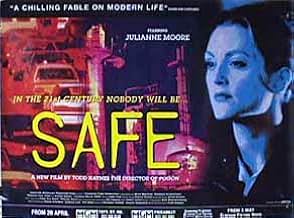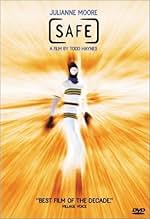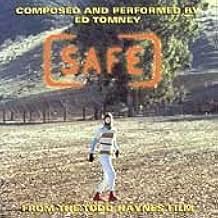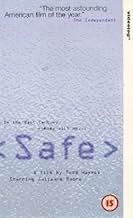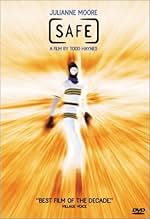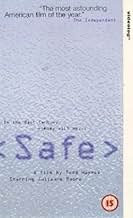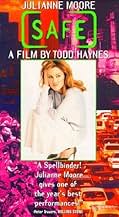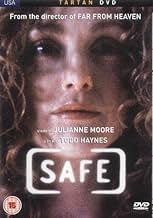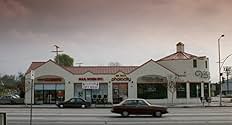VALUTAZIONE IMDb
7,1/10
18.650
LA TUA VALUTAZIONE
Una casalinga benestante e non eccezionale sviluppa una sensibilità chimica multipla.Una casalinga benestante e non eccezionale sviluppa una sensibilità chimica multipla.Una casalinga benestante e non eccezionale sviluppa una sensibilità chimica multipla.
- Regia
- Sceneggiatura
- Star
- Premi
- 4 vittorie e 13 candidature totali
Martha Velez
- Fulvia
- (as Martha Velez-Johnson)
Chauncey Leopardi
- Rory
- (as Chauncy Leopardi)
Allan Wasserman
- Client
- (as Alan Wasserman)
Jean St. James
- Client's Wife
- (as Jean Pflieger)
Recensioni in evidenza
Julianne Moore is one of my favorite actresses and that's the reason I decided to watch this one.
This film is labeled as Drama/Thriller. Well, the drama's here, no doubt, as Carol White (Moore) slowly begins to succumb to the multiple effects of all types of pollution that pervade our technocratic consumer societies. There's psychological drama also as her husband, Greg (Xander Berkeley) tries to come to some understanding about Carol and how his marriage seems to be slowly disintegrating. And, there's drama also when Carol reacts violently to various chemicals, such that she is hospitalized and undergoes a battery of tests...
But... Thriller? Not at all, not by a long shot.
This is something better than mere thrills at one level, it's a modern horror story that we are all living, because we are all part of this petrochemical world that we cannot reasonably escape. At another level, it's also the horror that results when a person decides to dislocate from the polluted world we all live in and construct another world within the mind. The end result of such an act is usually madness... eventually.
Beautifully acted by all the players, so that it seems that they aren't acting; it is, after all, all too real, is it not? The musical background is simply stunning brooding, dark, menacing, and reminiscent of a David Lynch soundtrack. Visually, for the first half, you are battered with repetitive images of unending lines of traffic, excessive noise, mindless activities, rampant consumerism all designed to reflect the battered mind and body of Carol as she struggles to determine her future in a world that is increasingly threatening.
How she does that forms the second half. Does she succeed? I could say Yes and No, but I'll leave it up to you to decide when you see it. Enjoy...if you can!
This film is labeled as Drama/Thriller. Well, the drama's here, no doubt, as Carol White (Moore) slowly begins to succumb to the multiple effects of all types of pollution that pervade our technocratic consumer societies. There's psychological drama also as her husband, Greg (Xander Berkeley) tries to come to some understanding about Carol and how his marriage seems to be slowly disintegrating. And, there's drama also when Carol reacts violently to various chemicals, such that she is hospitalized and undergoes a battery of tests...
But... Thriller? Not at all, not by a long shot.
This is something better than mere thrills at one level, it's a modern horror story that we are all living, because we are all part of this petrochemical world that we cannot reasonably escape. At another level, it's also the horror that results when a person decides to dislocate from the polluted world we all live in and construct another world within the mind. The end result of such an act is usually madness... eventually.
Beautifully acted by all the players, so that it seems that they aren't acting; it is, after all, all too real, is it not? The musical background is simply stunning brooding, dark, menacing, and reminiscent of a David Lynch soundtrack. Visually, for the first half, you are battered with repetitive images of unending lines of traffic, excessive noise, mindless activities, rampant consumerism all designed to reflect the battered mind and body of Carol as she struggles to determine her future in a world that is increasingly threatening.
How she does that forms the second half. Does she succeed? I could say Yes and No, but I'll leave it up to you to decide when you see it. Enjoy...if you can!
There are some that feel that a thriller has to be a rollercoaster ride with thrills and spills every minute. This film is not that kind of thriller. SAFE is like those chilling dreams where you are being dragged through something somewhat familiar yet otherworldly and just out of reach of total comprehension. Those sort of dreams are annoying, but we all have them anyway. Some people shrug them off, some think they can explain it away by analysis, and some just like to bask in the fact that they are mysterious, heart-palpitating, and fascinating. I'm in the latter category, and such is my love for this film. This film is like a kaleidoscope where the patterns seem fixed and definable, yet are constantly changing.
There's no doubt that Todd Haynes has something to say about the toxicity of our environment, the toxicity of our relationships, the toxicity of our generic society, and even the toxicity of our venues of healing. Doctors and psychiatrists for example, are cold and sterile and seemingly wearing blinders and cotton in their ears when it comes to really seeing or listening to their patients. New Age healers on the other hand are warm and receptive and seemingly interested in seeing you, hearing you and knowing you. But they trod down the same path that religious fundamentalists do. If your faith isn't strong enough; you won't be healed. One recollects New Age healers' like Louise Hay who claimed that AIDS victims had subliminal desires to hurt themselves, but could be cured with a strong dose of self-love. An especially nasty ruse, when one considers how most of society has already blamed the victim. AIDS victims shouldn't blame themselves, but they shouldn't believe that enough' faith will heal them either. So we can feel for Carol White (as generic sounding a name as one could imagine!) who knows her illness to be real, but who feels guilty nonetheless because no one will let her own her illness. They don't even know she exists, really. And she, from the beginning of this film, isn't sure either.
Carol is an enigma to herself. She's like a fish in an aquarium (her house in fact, looks sort of like a dungeon set in a space-age aquarium), only she never really saw her life as such until she reached the pinnacle of success defined by society. At the opening of the film, she's got it all': wealth, security, servants, friends', family' and health (well, for the time being). But what happens when you've reached the pinnacle of success? Just be happy going to dull social functions and decorate your proverbial palace? Carol begins to see her life her aquarium- from outside. It's dull, blue and facile. A person who has a sense of self could try to survive in the ocean' of life, but Carol isn't such a person. So it's not so unnatural that she might become so vilely inebriated by the blandness and inanity of her life that she can barely talk and ultimately, can barely breathe. One can get literally ill with an overdose of generic, stupefying life. Ever been stuck in a dentist's waiting room listening to the likes of Tony Orlando and Dawn or Linda Ronstadt? We're talking real nausea here! So imagine being a person who lives in a 24/7 world of pastel colours, pop musak, shopping, vacuous conversation with friends', and being married to a man who has less charisma than a houseplant. Depression of that magnitude would leave any person raw. Carol's blues (which we can see literally in the lighting of her house and in the God-awful furniture) have broken her. Once she realized how raw she'd become, she lost all sense emotionally and physically- in how to cope. Perhaps the reason that no one could help her was that they were all too busy enjoying the decor of their proverbial aquariums. Her husband, her friends, her doctors, even the new Age healers, LIKE the limited, appropriately fashioned, seemingly inoffensive world they've found their niche in. Gosh knows, I've thought myself nuts for not being part of the majority of the population that likes shopping malls, industrial architecture, Nike, Julia Roberts, or franchise coffee houses' that serve their overpriced coffee in paper cups. I kind of understand why Carol would want to bury herself in an igloo by the end of the film. But New-Agey as it may be, there is a glimmer of hope when she stands at the mirror and chokes out `I love you' to her reflection. It's not exactly Descartes' `I think, therefore I am', but its affirmation enough that she does indeed have a face and a heart. She does indeed exist. I think that's what Todd Haynes' message to us is. SAFE is a cry for us to take a good, hard look at the world around us, to recognize its variety of poisons, and to make a stand to save it and to save ourselves.
There's no doubt that Todd Haynes has something to say about the toxicity of our environment, the toxicity of our relationships, the toxicity of our generic society, and even the toxicity of our venues of healing. Doctors and psychiatrists for example, are cold and sterile and seemingly wearing blinders and cotton in their ears when it comes to really seeing or listening to their patients. New Age healers on the other hand are warm and receptive and seemingly interested in seeing you, hearing you and knowing you. But they trod down the same path that religious fundamentalists do. If your faith isn't strong enough; you won't be healed. One recollects New Age healers' like Louise Hay who claimed that AIDS victims had subliminal desires to hurt themselves, but could be cured with a strong dose of self-love. An especially nasty ruse, when one considers how most of society has already blamed the victim. AIDS victims shouldn't blame themselves, but they shouldn't believe that enough' faith will heal them either. So we can feel for Carol White (as generic sounding a name as one could imagine!) who knows her illness to be real, but who feels guilty nonetheless because no one will let her own her illness. They don't even know she exists, really. And she, from the beginning of this film, isn't sure either.
Carol is an enigma to herself. She's like a fish in an aquarium (her house in fact, looks sort of like a dungeon set in a space-age aquarium), only she never really saw her life as such until she reached the pinnacle of success defined by society. At the opening of the film, she's got it all': wealth, security, servants, friends', family' and health (well, for the time being). But what happens when you've reached the pinnacle of success? Just be happy going to dull social functions and decorate your proverbial palace? Carol begins to see her life her aquarium- from outside. It's dull, blue and facile. A person who has a sense of self could try to survive in the ocean' of life, but Carol isn't such a person. So it's not so unnatural that she might become so vilely inebriated by the blandness and inanity of her life that she can barely talk and ultimately, can barely breathe. One can get literally ill with an overdose of generic, stupefying life. Ever been stuck in a dentist's waiting room listening to the likes of Tony Orlando and Dawn or Linda Ronstadt? We're talking real nausea here! So imagine being a person who lives in a 24/7 world of pastel colours, pop musak, shopping, vacuous conversation with friends', and being married to a man who has less charisma than a houseplant. Depression of that magnitude would leave any person raw. Carol's blues (which we can see literally in the lighting of her house and in the God-awful furniture) have broken her. Once she realized how raw she'd become, she lost all sense emotionally and physically- in how to cope. Perhaps the reason that no one could help her was that they were all too busy enjoying the decor of their proverbial aquariums. Her husband, her friends, her doctors, even the new Age healers, LIKE the limited, appropriately fashioned, seemingly inoffensive world they've found their niche in. Gosh knows, I've thought myself nuts for not being part of the majority of the population that likes shopping malls, industrial architecture, Nike, Julia Roberts, or franchise coffee houses' that serve their overpriced coffee in paper cups. I kind of understand why Carol would want to bury herself in an igloo by the end of the film. But New-Agey as it may be, there is a glimmer of hope when she stands at the mirror and chokes out `I love you' to her reflection. It's not exactly Descartes' `I think, therefore I am', but its affirmation enough that she does indeed have a face and a heart. She does indeed exist. I think that's what Todd Haynes' message to us is. SAFE is a cry for us to take a good, hard look at the world around us, to recognize its variety of poisons, and to make a stand to save it and to save ourselves.
Although it's been almost ten years since filmmaker Todd Haynes (Velvet Goldmine, Far From Heaven) made Safe, the film's only secured cinematic release in Australia in 2004. As Safe quietly satirises the 80s, the delayed release improves it, adding another layer of perspective to a heroine who lives life in a series of bubbles.
It's 1987, and timid California housewife Carol (a young Julianne Moore) is immersed in upper-middle class minutiae ensuring her couch is the right colour, sleepwalking through a tepid aerobics class, and submitting to her husband (Greg White from 24). But gradually cracks appear in this pristine life, tiredness, unexplained illness until she is diagnosed with multiple chemical sensitivity. She then moves to Wrenwood, a healing retreat founded by the charismatic Peter (Peter Friedman) but will this solve her problem? Or is it just another escape? Safe is a very interesting film about a woman so overwhelmed by her environment that she becomes allergic to it. Writer and director Haynes has combined aspects of the disease film (e.g. Love Story) with the psychological thriller as Carol doesn't know what triggers her symptoms, the audience never knows when she'll have another attack.
While Haymes criticises the New Age belief that illness is psychologically-based, in Carol's case, it's impossible to separate the psychological and physical aspects of her illness. The cinematography shows her dwarfed by her environment and Haymes offers no easy solutions. ***½/***** stars.
It's 1987, and timid California housewife Carol (a young Julianne Moore) is immersed in upper-middle class minutiae ensuring her couch is the right colour, sleepwalking through a tepid aerobics class, and submitting to her husband (Greg White from 24). But gradually cracks appear in this pristine life, tiredness, unexplained illness until she is diagnosed with multiple chemical sensitivity. She then moves to Wrenwood, a healing retreat founded by the charismatic Peter (Peter Friedman) but will this solve her problem? Or is it just another escape? Safe is a very interesting film about a woman so overwhelmed by her environment that she becomes allergic to it. Writer and director Haynes has combined aspects of the disease film (e.g. Love Story) with the psychological thriller as Carol doesn't know what triggers her symptoms, the audience never knows when she'll have another attack.
While Haymes criticises the New Age belief that illness is psychologically-based, in Carol's case, it's impossible to separate the psychological and physical aspects of her illness. The cinematography shows her dwarfed by her environment and Haymes offers no easy solutions. ***½/***** stars.
I watched Safe for our coverage of 1980s's health movements and the AIDS virus with a special eye for the conflict between New Age healers and "the medical profession." Safe connects so well with both; although there's no real homosexuality anxieties in the film, AIDS seem the unconquerable illness penetrating the lives of happy suburban people.
First of all, Julianne Moore is absent in the film. Her character, Carol White, is a model, rich California suburban housewife. We notice how absent she is from the moment that sex with her husband produces nothing in her, but she goes through the motions of kissing him and petting him afterwards. She has mechanical conversations with friends, with mother, with cleaning lady in her ultramodern, lush, carpeted, fashionably lit house with gardens surrounding it and police patrol by night. She goes to her workouts, cleaners, and arranges furniture.
This is a really tragic film. It's also brilliantly shot, edited, acted, and its sets are so appropriate. The use of teal and sky blue becomes numbing, anesthetizing in Carol's home, as does the harsh lighting of the doctor's office and the hospital. The Wrenwood Center itself resembles where Deckard would have gone at the end of Blade Runner as the orig. end credits seemed to indicate: mountains and nature as an antidote to the city.
However, it's not URBAN life that seems to be killing Carol- it's SUBURBAN life, it's Northern California, it's fruit diets, mini-malls, 80s music playing in health clubs, housewifes, gardens, pools, teal green couches, endless lines of cars, power lines, and street lights. It's dismal, and her family life is no big help having no real life to it.
At one point, in a really wrenching scene, Carol cries, looks at Greg from the bed and asks "Where am I? Right now?" He responds flatly but tenderly, "You're in Carol and Greg's house." She only cries more.
The question is: what is really wrong with Carol White? Did she succumb to depression and make herself a psychosomatic illness? Is she really sick and dying? Is she just afraid of living? It seems to me the more that Carol is told that she is the only one with the power to cure herself, the less power she seems to have. The final monologue where she stands in front of the group and discusses how far she's come is inarticulate, random, unthought, and not a good sign.
The acting is done well for its purposes, especially by Peter Dunn, the leader. He creates an interesting portrait of a man who is so determined to be a victim that he's created people who are dependent on him. Peter is the only dynamic presence in the film, but even he wants peace, love, and tranquility in our hearts. That doesn't seem to feed Carol.
This film reminded me of Koyaanisqatsi, visions of emptiness and life out of balance. Carol looks out her car window at the highways and powerlines and headlights, and she reminded me of someone watching that film, fearing technology. Yet even retreating from technology is not an ALTERNATIVE: it's a sign of defeat, isn't it?
The film doesn't offer solutions- only one of the most frightening, eerie, and numbing indictments of suburbia and the New Age that I have ever seen. It puts its images, sets, sounds, actors into a collective vision of decay, expressed through the decline of the model suburban housewife. See it, but don't look for answers or happy endings.
First of all, Julianne Moore is absent in the film. Her character, Carol White, is a model, rich California suburban housewife. We notice how absent she is from the moment that sex with her husband produces nothing in her, but she goes through the motions of kissing him and petting him afterwards. She has mechanical conversations with friends, with mother, with cleaning lady in her ultramodern, lush, carpeted, fashionably lit house with gardens surrounding it and police patrol by night. She goes to her workouts, cleaners, and arranges furniture.
This is a really tragic film. It's also brilliantly shot, edited, acted, and its sets are so appropriate. The use of teal and sky blue becomes numbing, anesthetizing in Carol's home, as does the harsh lighting of the doctor's office and the hospital. The Wrenwood Center itself resembles where Deckard would have gone at the end of Blade Runner as the orig. end credits seemed to indicate: mountains and nature as an antidote to the city.
However, it's not URBAN life that seems to be killing Carol- it's SUBURBAN life, it's Northern California, it's fruit diets, mini-malls, 80s music playing in health clubs, housewifes, gardens, pools, teal green couches, endless lines of cars, power lines, and street lights. It's dismal, and her family life is no big help having no real life to it.
At one point, in a really wrenching scene, Carol cries, looks at Greg from the bed and asks "Where am I? Right now?" He responds flatly but tenderly, "You're in Carol and Greg's house." She only cries more.
The question is: what is really wrong with Carol White? Did she succumb to depression and make herself a psychosomatic illness? Is she really sick and dying? Is she just afraid of living? It seems to me the more that Carol is told that she is the only one with the power to cure herself, the less power she seems to have. The final monologue where she stands in front of the group and discusses how far she's come is inarticulate, random, unthought, and not a good sign.
The acting is done well for its purposes, especially by Peter Dunn, the leader. He creates an interesting portrait of a man who is so determined to be a victim that he's created people who are dependent on him. Peter is the only dynamic presence in the film, but even he wants peace, love, and tranquility in our hearts. That doesn't seem to feed Carol.
This film reminded me of Koyaanisqatsi, visions of emptiness and life out of balance. Carol looks out her car window at the highways and powerlines and headlights, and she reminded me of someone watching that film, fearing technology. Yet even retreating from technology is not an ALTERNATIVE: it's a sign of defeat, isn't it?
The film doesn't offer solutions- only one of the most frightening, eerie, and numbing indictments of suburbia and the New Age that I have ever seen. It puts its images, sets, sounds, actors into a collective vision of decay, expressed through the decline of the model suburban housewife. See it, but don't look for answers or happy endings.
Safe is perhaps a tad too ambiguous for its own good. The film focuses on a suburban housewife (Julianne Moore) who feels sick for no reason. Her doctor suggests psychological treatment, but she finds more comfort in the idea that her sickness is caused by environmental factors, such as car fumes and the like. Haynes never answers the question of what is really affecting Moore. One moment you're sure it's psychological, then physical symptoms displayed by the woman are undeniable. It's not that I really wanted the questions answered, but the constant toying with the audience does become a strain, especially as the film runs for two hours and not much happens. There's also the possibility that the story isn't meant to represent reality, but instead it might be allegorical. This makes it all the more difficult to unravel. I know I sound sort of negative in this review, but I did like it. I don't think it works completely, but I found it fascinating. One reason it does work at all is that Haynes' major goal seems to want to put us inside Moore's head. It shows us what it would be like to suffer and not know why, and how comfortable it might be to, say, join a cult, which is basically what she does in the end. Not entirely satisfying, but definitely well worth a look.
Lo sapevi?
- QuizWhen it came time for Julianne Moore to record the director's commentary for the 2003 DVD release, this was the first time the lead actress had seen the movie in its entirety.
- BlooperAlthough this film was explicitly set in 1987, while Carol is driving on the highway, she passes a burgundy 1992 Cadillac de Ville.
- Citazioni
Carol White: [about her declining health] I'm sorry. I know it's not normal but I can't help it.
I più visti
Accedi per valutare e creare un elenco di titoli salvati per ottenere consigli personalizzati
- How long is Safe?Powered by Alexa
Dettagli
- Data di uscita
- Paesi di origine
- Lingue
- Celebre anche come
- A salvo
- Luoghi delle riprese
- Aziende produttrici
- Vedi altri crediti dell’azienda su IMDbPro
Botteghino
- Budget
- 1.000.000 USD (previsto)
- Lordo Stati Uniti e Canada
- 512.245 USD
- Fine settimana di apertura Stati Uniti e Canada
- 15.830 USD
- 25 giu 1995
- Lordo in tutto il mondo
- 512.558 USD
Contribuisci a questa pagina
Suggerisci una modifica o aggiungi i contenuti mancanti


